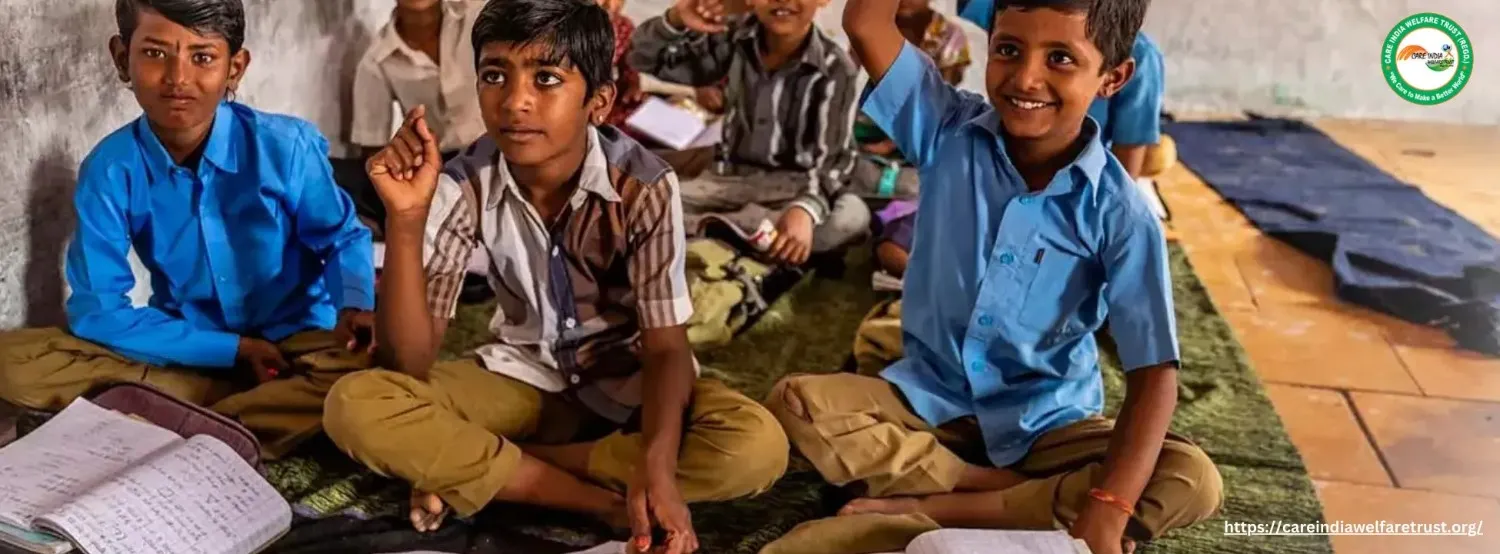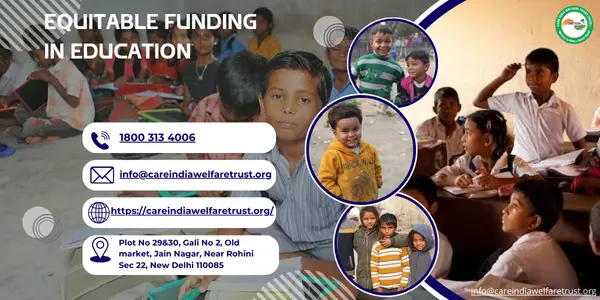Education is the key to success and a better future, but sometimes not every child has the same access to it. This often is much more difficult for many children, particularly those from low-income families. The solution is clear, Equitable funding in education
Transforming Education with equitable financing has to be the answer to ensuring that all children, no matter their backgrounds, are supported enough for success.
Fair Funding in Education
Equitable funding in education is the idea of spreading cash in a manner such that all children get access to quality education irrespective of where they live and regardless of how much their families earn. It does not mean simply giving everyone the same amount of money to spend, but that underprivileged children should receive extra resources to help them make it up and succeed.
We also know the value of education. Our NGO Care India Welfare Trust is the Best NGO in Delhi. Apart from Delhi, Care India Welfare Trust also serves different states such as Kolkata, Bengaluru, Hyderabad, Jharkhand, Tamil Nadu, and Andhra Pradesh. Under such initiatives, the trust gives out free Education to children from lower caste and marginalized communities, provides healthcare services for the same communities, skill development programs for women, and emergency help in times of natural disasters to create a better and more equitable society for all through these initiatives.
Who Introduced the Education System in India
Lord Thomas Babington Macaulay introduced the education system in india. The modern education system we see in India had been made by the British during their colonization period. The British had established schools, colleges, and universities, but education was only for a selected few. But, after independence, India has gone through changes that improved and expanded the education system into one that makes it possible for all children to access education for peaceful coexistence, regardless of their backgrounds.
About the Indian Education System
In the past years, the Indian education system has been the most powerful weapon but nowadays Indian education system is going slow because most of the parents have stopped their children's studies and they doing starting to labor because of their home financial conditions. Their parents did not have money to invest in these children our organization helps they can educate these students without taking any amount they can invest their amount on these children. Care India Welfare Trust knows the importance of education for girls mostly because many slum areas of india did not educate their girls they can marry their girls at the age of 16-18. That's why we face different types of cases in india. If you want to join us to help these children then you can connect with us by donating for them you can visit the NGO.
Present Education System in India
The Indian education system encompasses various stages, starting from primary schooling and heading to higher education. Endeavors have been made by the Government to raise literacy levels and provide free and compulsory education for children. But much has to be done to guarantee that every child should have a quality education, especially in rural areas.
10 Reasons Why Technology is Good for Education
Technology in education has been quite instrumental and enables benefits for the teachers and the students. Here are 10 reasons why one should appreciate technology in education:
1. Information accessibility:- Technology has made it easy to access all forms of learning materials.
2. Engagement:- Interactive tools turn learning into a much more interesting experience for the student.
3. Personalized learning:- Technology can be adapted to meet the needs of each learner.
4. Collaboration:- Students can provide a platform to share thoughts and ideas online.
5. Efficiency:- Using technology helps cut the time required to create and review learning.
6. Indeed, Distant Learning:- Learners continue with their lessons, even at home or anywhere else.
7. Global Reach:- This has brought the students close connections with their peers and colleagues studying all over the world.
8. Skill Development:- Teach students important digital skills using technology.
9. Cost-effective:- It becomes cheaper in the long run than traditional means.
10. Innovation:- Technology is all about innovation and is at the very core of development in and out of the classroom.
Contribution of Technology in Education
The contribution of technology the education also has an important role because most students do not have money to join tutors so these students study Online through YouTube and other apps. Today, education is more affordable and accessible than ever. Digital teaching and learning, allow students to study at their convenience instead of limiting them to various sources and making them easily accessible to others around the world. Nevertheless, this innovation brings forth a new revolution in the contribution of technology to education and hopes for a better future.
Modes of Education
According to the current definition, education does not just take place in classrooms. Due to technology, education has been diversified into numerous avenues like online learning, blended learning, and distance learning, making modes of education much more flexible and accessible to everyone, particularly to those for whom attending a traditional school poses a concern.
Role of Social Agencies in Promoting Peace Education
Social agencies and organizations are very instrumental in developing peace education in various parts of the world. With their resource provision, teacher training, and supportive conditions, teaching will be integrated into the education system. These agencies play a role as well in propagating the message of peace and tolerance to larger communities, ultimately leading toward more peaceful societies.
NGOs' Thoughts about Equitable Funding In Education
The NGOs thought that Equitable Funding In Education was essential for creating an inclusive and fair education system. The Care India Welfare Trust NGO knows that children from the poor experience significant challenges while facing education barriers such as poverty, lack of resources, and limited access to good schooling. While this profit ensures that resources are distributed in such a way that it focuses on the neediest, it helps disadvantaged students gain access to the same opportunities as other fellow learners. It supports children's advocacy efforts and voices in favor of the government policies developed by Care India that create a supportive policy environment for such schools, with special emphasis on their infrastructure, teacher training, and learning materials.
FAQ
What are the Advantages and Disadvantages of Technology in Education?
There are many advantages and disadvantages of technology in education. Some children take the help of technology to collect knowledge but most children misuse they play games or use many social media platforms.
What Is Equitable Funding?
Equitable financing means an equitable distribution of resources to education so that children who require greater assistance, like poor or disadvantaged ones, are offered the support they need.
What Is The Role Of NGOs In The Education Sector?
NGOs are an important part of the education sector. They are providing resources, improving access to education, supporting excluded communities, training teachers, and advocating for better policies so that education can reach all at its highest quality.



